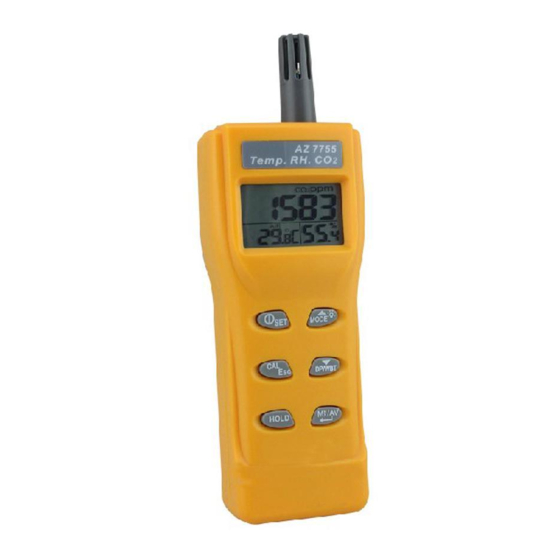
Advertisement
Advertisement
Table of Contents

Summary of Contents for az-instrument 7755
- Page 1 PORTABLE CO METER User Manual English and Deutsche Languages...
-
Page 2: Material Supplied
INTRODUCTION Thank you for purchasing this portable CO meter. The meter measure CO level, air temperature, dew point, wet bulb temperature and humidity (DP, WB and RH) and is an ideal instrument for indoor air quality (IAQ) diagnosis. Poor indoor air quality is considered unhealthy because it causes tiredness, loss of ability to concentrate, and even illness (ex. -
Page 3: Lcd Display
LCD DISPLAY concentration in ppm Air temp, Dew point, Welt Relative humidity in % bulb temp in °C or °F Time weighted average (8 hours) STEL Short-term exposure limit (15 minutes weighted average) HOLD Readings are freeze unchanged MIN/MAX Minimum/Maximum reading Low battery indicator Dew point temperature Air temperature... -
Page 4: Taking Measurement
• TAKING MEASUREMENT The meter starts measurement when power on and update readings every second. In the condition of operating environment changed (Ex. From high to low temperature), it takes 30 seconds to respond for CO sensor and 30 minutes for RH. NOTE: Do not hold the meter close to faces in case exhalation affects CO levels. -
Page 5: Auto Power Off
• ALARM The meter features audible alarm to give warnings when CO concentration exceeds the limit. (See P1.0 in setup for setting the alarm threshold). It emits beeps (Abt. 80dB) when CO level goes over the set value and stops when any key (except “ ”... - Page 6 The manual calibration is suggested to be done in fresh outdoor air that is well ventilated and in sunny weather. Place the meter in the calibration site. Turn on the meter and hold down “ ” and “ ” simultaneously to enter CO calibration mode (Fig.
-
Page 7: Troubleshooting
“CAL” and calibrating value (75.2% if at 25°C) are blinking on the LCD with current temperature at the left. Meter is now calibrating. Wait about 60 minutes until blinking stops, then calibration is completed and it returns to normal mode. NOTE: Users can also calibrate either point. -
Page 8: Response Time
ACCURACY ±50ppm±5% (0~2000ppm) Temperature ±0.6°C / ±0.9°F ±3% RH (at 25°C, 10~90%RH); Humidity ±5%RH (at 25°C, others) Warm-up time 30 seconds RESPONSE TIME <30 seconds (90% step change) Tair <2 minutes (90% step change) <10 minutes (90% step change) Relay LCD size (H) 26 x (W) 44 mm Operating condition... -
Page 9: Warranty
• REGULATORY EXPOSURE LIMIT ASHREA Standard 62~1989: 1000ppm concentration in occupied building should not exceed 1000ppm. Building bulletin 101 (BB101): 1500ppm UK standards for schools say that CO at averaged over the whole day (i.e. 9am to 3:30pm) should not exceed 1500ppm. OSHA: 5000ppm Time weighted average over five 8-hour work days should not exceed 5000ppm.







Need help?
Do you have a question about the 7755 and is the answer not in the manual?
Questions and answers